Sitting too long on your sofa weakens your muscles, lowers bone density, and hampers circulation, increasing the risk of osteoporosis, heart disease, and circulatory problems. It also impacts your posture, causing stiffness and discomfort, while negatively affecting mental health by reducing mood-boosting endorphins. If you want to understand how your favorite resting spot may be harming you—and discover ways to stay healthier—the full picture might surprise you.
Key Takeaways
- Prolonged sofa sitting weakens muscles, reduces endurance, and causes muscle atrophy, impairing daily function and increasing injury risk.
- Extended lounging decreases bone density due to lack of weight-bearing movement, raising osteoporosis and fracture risks.
- Sitting for long periods impairs circulation, leading to blood pooling in legs, swelling, and increased cardiovascular strain.
- Excessive sofa time lowers endorphin release, contributing to anxiety, depression, and decreased mental well-being.
- Sedentariness from prolonged sofa use promotes fat buildup, lowers HDL cholesterol, and heightens risk of heart disease and metabolic issues.
The Hidden Costs of Sitting Too Much

Sitting for extended periods might seem harmless, but it secretly takes a toll on your health. When you spend hours glued to the sofa or at a desk, your muscles weaken, and your posture suffers. Switching to ergonomic furniture can help reduce strain, providing better support and encouraging proper alignment. Consider replacing traditional chairs with ergonomic options that promote movement and comfort. Standing desks are another effective tool; they let you alternate between sitting and standing, decreasing the negative effects of prolonged sitting. These adjustments don’t just improve comfort—they also lower your risk of developing chronic health issues linked to sedentary lifestyles. By integrating ergonomic furniture and standing desks into your routine, you’re taking a proactive step toward healthier habits. Incorporating vertical storage solutions can further optimize your space, making it easier to stay active and organized throughout the day.
How Sedentary Lifestyles Affect Your Muscles and Bones
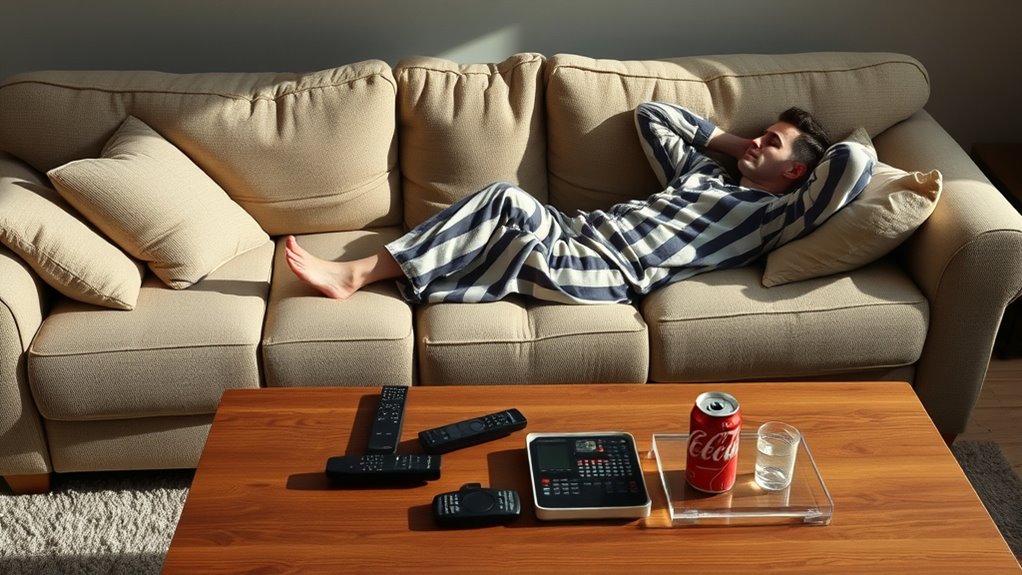
When you stay sedentary, your muscles can weaken and shrink over time, making everyday activities harder. Your bones also lose density without regular weight-bearing movement, increasing the risk of fractures. Plus, sitting too much reduces joint flexibility, leading to stiffness and discomfort. Engaging in movement can help maintain vibrational energy, supporting overall physical health and vitality.
Muscle Weakening Risks
Prolonged periods of inactivity can lead to significant muscle and bone weakening, making everyday movements more difficult and increasing injury risk. When you stay sedentary, muscle atrophy occurs, causing your muscles to shrink and weaken. This leads to a clear strength decline, reducing your ability to perform simple tasks like lifting or walking. Additionally, a lack of activity can negatively impact your muscle endurance, further compromising your physical health.
| Effect | Consequence |
|---|---|
| Muscle atrophy | Loss of muscle size and power |
| Strength decline | Reduced physical capability |
| Increased injury risk | Higher chance of strains and falls |
Without regular activity, your muscles lose their tone and endurance, making you more prone to injuries. Staying active helps prevent these risks and keeps your muscles strong and resilient.
Bone Density Loss
A sedentary lifestyle accelerates bone density loss, weakening your skeletal structure over time. When you sit too much, your bones don’t get the weight-bearing activity they need to stay strong. This reduces calcium absorption, which is essential for maintaining bone strength. Without regular movement, your bones become less dense and more fragile, increasing the risk of fractures and osteoporosis. Exercise stimulates the production of bone tissue, helping preserve your skeletal integrity. Even simple activities like walking or standing can make a difference. If you stay inactive, your bones won’t receive the signals they need to rebuild and reinforce themselves. Over time, this imbalance leads to weaker bones, making everyday activities more hazardous. To protect your bone health, incorporate movement into your daily routine and avoid prolonged periods of sitting.
Joint Flexibility Decline
Sedentary lifestyles cause your joints to stiffen and lose their natural range of motion over time. This joint stiffness reduces flexibility and can lead to pain or injury. To combat this decline, consider these steps:
- Incorporate daily flexibility training to maintain joint mobility.
- Stretch major muscle groups regularly to prevent stiffness.
- Move frequently—avoid long periods of sitting without breaks.
- Strengthen supporting muscles to improve stability and joint function.
The Impact of Prolonged Sitting on Heart Health
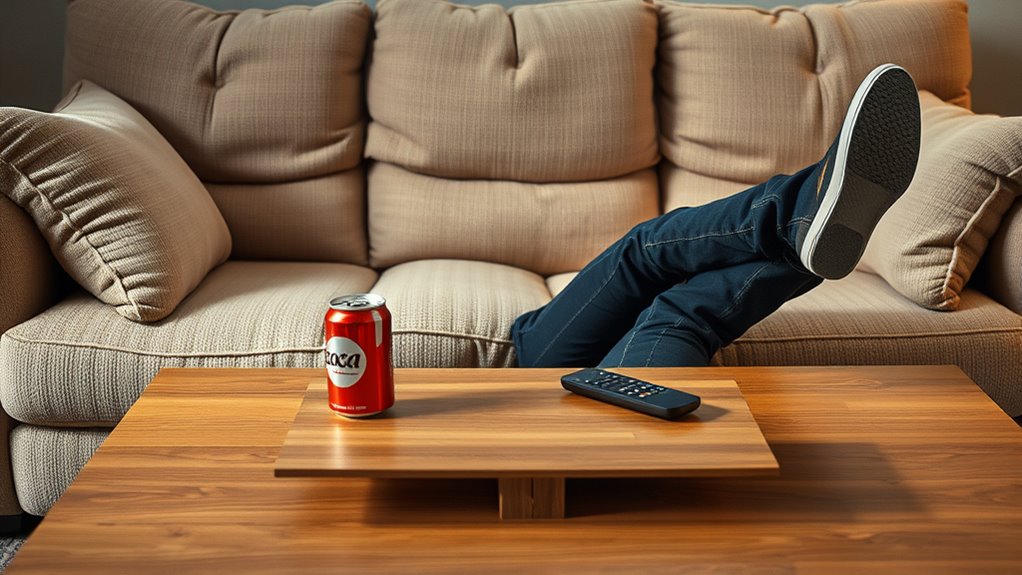
When you sit for long periods, your risk of heart problems increases markedly. Your blood circulation slows down, making it harder for your heart to function efficiently. Over time, this can lead to serious issues like heart disease. Additionally, neglecting progress reviews of your activity levels can make it harder to recognize early warning signs and implement necessary lifestyle changes.
Increased Cardiovascular Risk
Prolonged sitting directly increases your risk of developing cardiovascular problems by impairing blood flow and promoting inflammation. Sedentary behavior, especially when you’re comfortable on your couch, can have serious effects. Here’s how it impacts your heart health:
- Raises blood pressure over time, stressing your arteries.
- Increases bad cholesterol levels, clogging your arteries.
- Promotes weight gain, adding strain to your heart.
- Triggers inflammation, damaging blood vessel walls.
- Using a hybrid bike for regular activity can help counteract these effects by promoting movement and cardiovascular health.
Your couch comfort may feel relaxing, but staying in one position for hours hampers circulation and encourages these risks. Reducing sedentary behavior, taking regular breaks, and staying active are vital to lowering your cardiovascular risk. Remember, what feels comfortable now could compromise your heart health later.
Blood Circulation Challenges
Sitting for long periods hampers your blood circulation, making it harder for your heart to pump blood efficiently throughout your body. This reduced blood flow can lead to circulatory fatigue, where your muscles and tissues don’t get enough oxygen and nutrients. When you stay seated, blood tends to pool in your legs, increasing pressure on blood vessels and decreasing overall circulation. Over time, poor blood flow stresses your cardiovascular system, forcing your heart to work harder. This strain can weaken your heart and impair its ability to circulate blood properly. The longer you remain sedentary, the more your circulatory system struggles, which can contribute to discomfort, swelling, and long-term health issues. Incorporating movement or active breaks into your routine can significantly improve blood flow and support your heart health.
Heart Disease Development
Have you ever wondered how extended periods of inactivity can increase your risk of heart disease? Sitting for too long reduces your calorie burning, leading to weight gain and increased strain on your heart. It also causes muscle atrophy, weakening your cardiovascular system’s support. Here’s how prolonged sitting impacts your heart health:
- Decreases overall calorie expenditure, promoting fat buildup.
- Contributes to muscle atrophy, weakening heart and vascular muscles.
- Lowers HDL cholesterol, the “good” kind that protects your arteries.
- Raises blood pressure and promotes inflammation, increasing artery damage risk.
- Ignoring Nike Tech innovations in athletic wear can reduce motivation to stay active, further impacting cardiovascular health.
Skipping movement sessions makes your heart work harder and accelerates plaque formation. Staying active helps maintain healthy calorie burning and muscle strength, protecting you from heart disease.
Mental Well-being and Sedentary Behavior
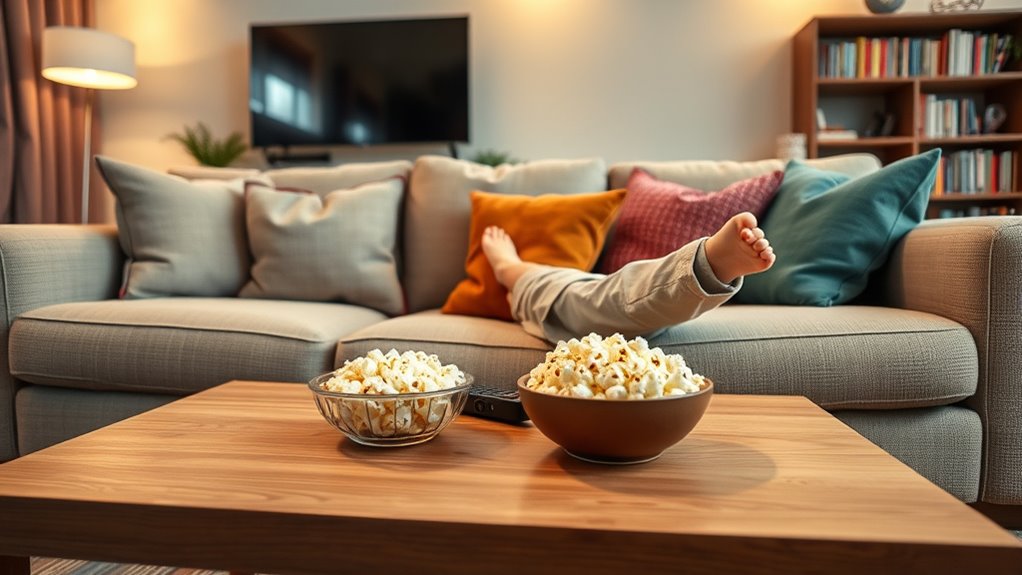
Ever wondered how your daily habits impact your mental well-being? Sitting for long periods can increase feelings of anxiety and depression, making stress management more challenging. Sedentary behavior reduces the release of endorphins, your body’s natural mood lifters. Incorporating mindfulness meditation into your routine can help you stay present and reduce negative thoughts. Regular movement, even gentle stretching, boosts mental clarity and lowers stress levels. When you spend hours on the sofa, you’re missing out on opportunities to elevate your mood naturally. Being active promotes better sleep and helps regulate emotions. Exploring ways to incorporate movement and activity into your day can significantly improve your mental health. So, breaking up your sitting time with mindful practices and movement isn’t just good for your body—it’s essential for maintaining a healthy mind.
The Science Behind Posture and Spinal Health
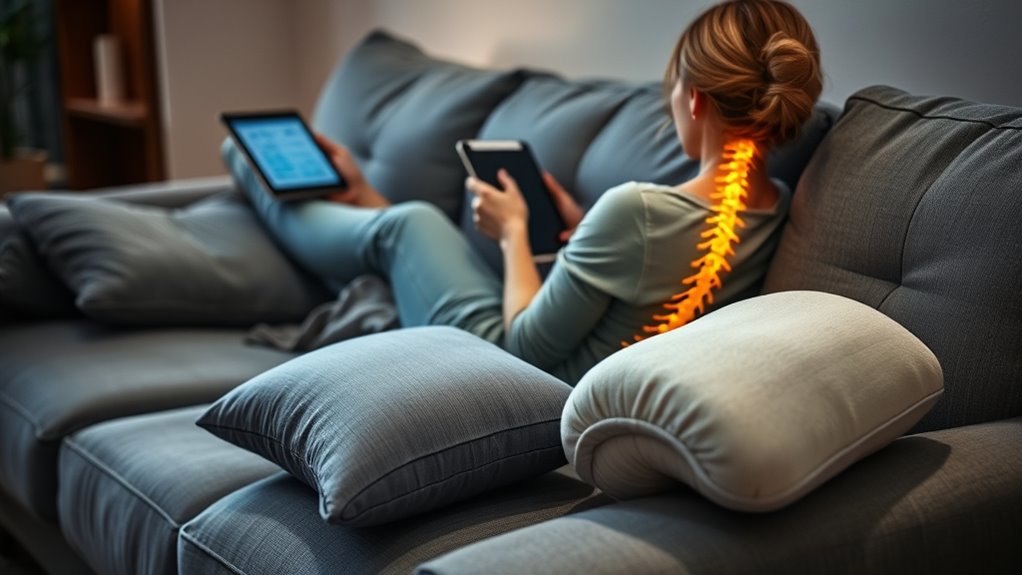
Understanding how your posture affects your spinal health reveals the importance of proper alignment. When you sit with correct spinal alignment, you reduce strain on your muscles and ligaments, preventing long-term issues. An ergonomic setup helps maintain this alignment by supporting natural curves of your spine. To optimize your posture, consider these key points:
- Keep your feet flat on the floor.
- Use a chair that supports your lower back.
- Position your monitor at eye level.
- Avoid slouching or leaning forward.
Additionally, incorporating natural elements into your workspace can promote relaxation and enhance overall comfort.
Breaks and Movement: Strategies to Counteract Sitting
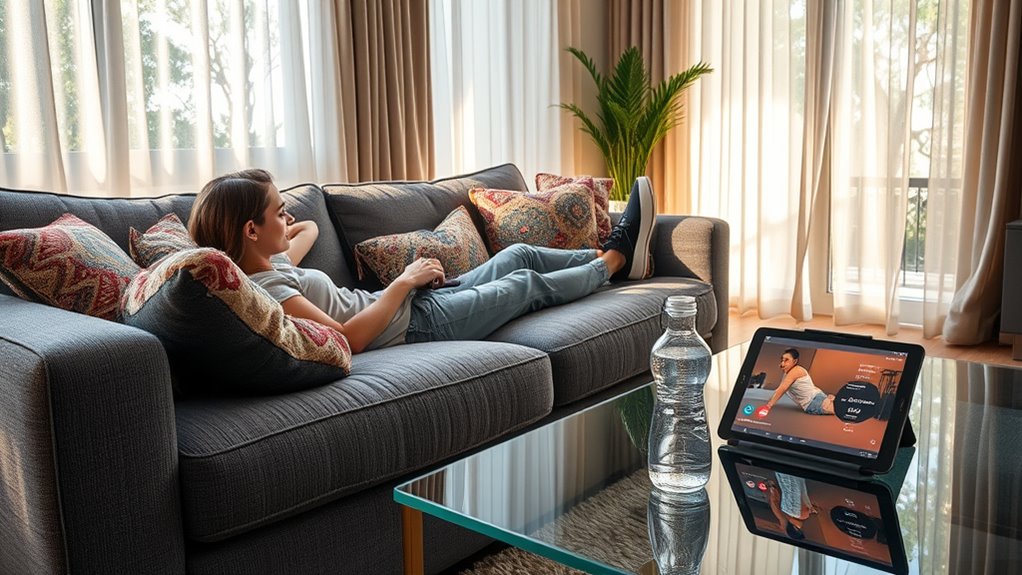
Maintaining proper posture is essential, but staying seated for long periods can still take a toll on your body. To combat this, incorporate active breaks into your routine. Every 30 to 60 minutes, stand up, stretch, or walk around for a few minutes. Using a standing desk can help reduce the negative effects of prolonged sitting by allowing you to switch between sitting and standing throughout the day. These small changes boost circulation, reduce muscle stiffness, and improve alertness. Even simple movements like ankle rolls or shoulder shrugs during breaks can make a difference. Prioritizing regular movement breaks keeps your muscles active and helps prevent the long-term health risks associated with extended sitting. Incorporating movement-friendly furniture into your workspace can further support your efforts to stay active. Your body will thank you for staying mobile and engaged.
The Role of Technology in Promoting Sedentary Habits

While technology has revolutionized how we work and communicate, it also plays a significant role in promoting sedentary behaviors. You might find yourself glued to screens for hours, often replacing physical activity with virtual workouts or screen-based entertainment. Wearable tech, like fitness trackers, can motivate you to move but sometimes lead to complacency if you rely solely on data. Consider these factors:
- Streaming services encourage binge-watching instead of active breaks.
- Virtual workouts can be convenient but may replace outdoor activities.
- Wearable tech tracks activity, yet can foster guilt rather than motivation.
- Smartphones and computers facilitate sedentary tasks, reducing movement naturally.
Technology’s convenience often means less physical effort, making it easier to stay seated longer. Recognizing these influences helps you make mindful choices.
Tips for Balancing Rest and Physical Activity
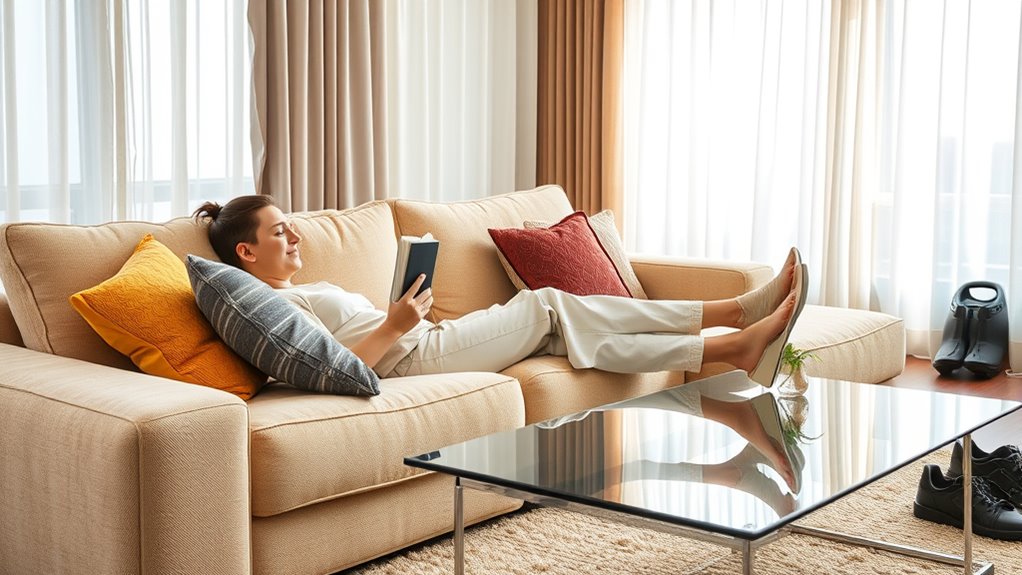
Balancing rest and physical activity is key to staying healthy without sacrificing comfort. Start by choosing ergonomic seating that supports good posture during downtime, reducing strain and discomfort. Incorporate active hobbies into your routine, like walking, cycling, or dancing, to break up long periods of sitting. Set reminders to stand up and stretch every 30 minutes, helping to improve circulation and prevent stiffness. Make physical activity enjoyable by pairing it with activities you love, such as listening to music while exercising or exploring outdoors. Prioritize quality rest, but don’t let it replace movement. Small, consistent efforts—like using ergonomic furniture and engaging in active hobbies—help you maintain a healthy balance between relaxation and activity, supporting overall well-being without sacrificing comfort.
Future Trends in Reducing Sedentary Risks

As technology advances, innovative solutions are emerging to help reduce the risks of a sedentary lifestyle. Future trends focus on integrating ergonomic furniture and standing desks into daily routines. These tools encourage movement and proper posture, making it easier to stay active while working or relaxing. Here are four key trends to watch:
- Smart ergonomic furniture that adjusts automatically to your posture.
- Adjustable standing desks with integrated health tracking.
- Mobile apps that remind you to move and stretch regularly.
- Virtual reality workouts that make movement engaging and accessible at home.
These developments aim to transform your environment, helping you break free from prolonged sitting and reduce health risks associated with sedentariness. Staying proactive now sets the stage for healthier habits tomorrow.
Frequently Asked Questions
How Does Prolonged Sitting Affect Brain Function and Cognitive Abilities?
Prolonged sitting can negatively impact your brain function and cognitive abilities. When you sit for too long, it increases the risk of neurodegeneration, which can impair memory and thinking skills. You might also experience mental fatigue more quickly, reducing your focus and problem-solving ability. Staying active helps boost blood flow to your brain, supporting better neuroplasticity and mental clarity, so avoid lengthy sitting sessions to keep your mind sharp.
Can Specific Exercises Counteract the Negative Effects of a Sedentary Lifestyle?
Think of your body as a delicate engine, craving movement to stay sharp and energized. Yes, you can outrun the sluggishness by doing desk stretches or switching to standing desks. These small acts act like sparks, reigniting circulation and flexibility. Incorporate these exercises into your day, and you’ll notice your body humming with vigor, counteracting the silent drain of sitting too long. Keep moving, and your health will thank you.
What Are the Long-Term Consequences of Sitting for Extended Periods Daily?
Sitting for long periods daily can lead to serious long-term consequences. You might experience muscle atrophy, where your muscles weaken and shrink due to inactivity. Additionally, your metabolic rate slows down, making it harder to burn calories efficiently. Over time, this increases your risk of obesity, cardiovascular disease, and type 2 diabetes. To avoid these effects, take regular breaks, stand up often, and incorporate movement into your daily routine.
How Does Sedentary Behavior Influence Sleep Quality and Patterns?
Imagine your body’s a delicate clock, and sedentary behavior is like dulling its gears. Sitting too long can cause sleep disruptions and throw off your circadian rhythms, making it harder to fall asleep and wake refreshed. Your body craves movement to reset these rhythms; without it, your sleep suffers. So, stand up, move around, and keep your internal clock ticking smoothly for better rest and overall health.
Are There Age-Related Differences in How Sitting Impacts Health Risks?
You might notice that sitting impacts your health differently as you age. Age-related metabolic changes can make prolonged sitting more risky for younger adults, but for the elderly, mobility challenges heighten these risks. Sitting too long can worsen health outcomes, especially if you face mobility issues. Staying active and reducing sedentary time becomes increasingly important to protect your health, regardless of age.
Conclusion
Imagine your body as a garden; too much sitting is like neglecting your plants, causing weeds to take over. Studies show that prolonged sitting increases your risk of heart disease, muscle loss, and mental fatigue. By moving regularly, you’re watering and nurturing your garden, helping it thrive. So, don’t let your sofa be a weed-infested patch—stand up, stretch, and keep your body’s garden healthy and vibrant.









